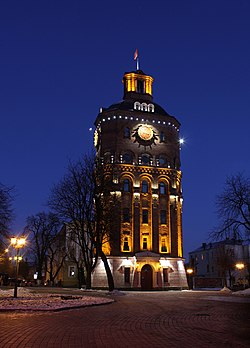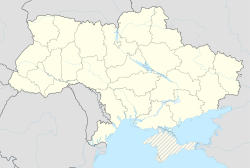Vinnitsya
|
Vinnytsia Вінниця |
|||
|---|---|---|---|

The former water tower in the center of Vinnytsia, Ukraine (now the War Veterans' Museum). View in the winter evening.
|
|||
|
|||
| Nickname(s): pearl of Podolia | |||
| Coordinates: 49°14′N 28°29′E / 49.233°N 28.483°ECoordinates: 49°14′N 28°29′E / 49.233°N 28.483°E | |||
| Country |
|
||
| Oblast |
|
||
| Raion | Vinnytsia City Municipality | ||
| Founded | 1363 | ||
| Government | |||
| • Head of City Council |
Serhiy Morhunov (Vinnytsia European Strategy) | ||
| Area | |||
| • City | 113,2 km2 (437 sq mi) | ||
| Population (2015) | |||
| • City | 372,484 | ||
| • Density | 5,066/km2 (13,120/sq mi) | ||
| • Metro | 660,000 | ||
| Time zones | UTC+2 | ||
| UTC+3 | |||
| Postal code | 21000- | ||
| Area code(s) | +380 432 | ||
| Sister cities | Birmingham, Kielce, Peterborough, Rybnytsia | ||
| Website | www.vmr.gov.ua | ||
Vinnytsia (Ukrainian: Ві́нниця, translit. Vinnytsia, pronounced [ˈβinːɪt͡sʲɐ]; Russian: Ви́нница, translit. Vinnitsa; Polish: Winnica; German: Winniza, and Romanian: Vinița) is a city in west-central Ukraine, located on the banks of the Southern Bug.
It is the administrative center of Vinnytsia Oblast and the largest city in the historic region of Podillia. Administratively, it is incorporated as a town of oblast significance. It also serves as an administrative center of Vinnytsia Raion, one of the 27 districts of Vinnytsia Oblast, though it is not a part of the district. Population: 372,484 (2015 est.)
A historic city known since Middle Ages and a former Soviet Cold War-airbase, Vinnytsia is now a modern cosmopolitan city.
The name of Vinnytsia appeared for the first time in 1363. It is assumed that the name is derived from the old Slavic word "Vino", meaning "given as a gift." This name can be explained by the fact that the Vinnytsia and surrounding land were captured by Lithuanian Duke Algirdas in the 14th century, and then, they were given as a gift to his nephews.
...
Wikipedia




